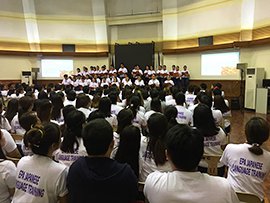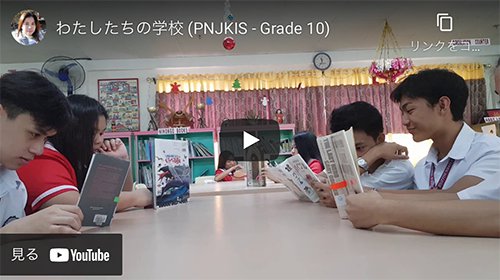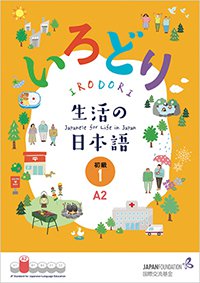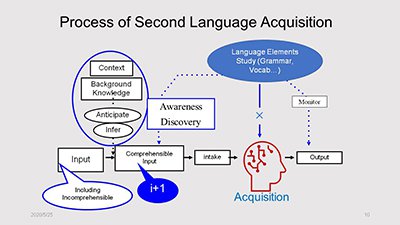The Japan Foundation, Manila
The Japan Foundation, Manila
EPA training team: IKEZU Joji, OGAWA Yasuko, EMORI Etsuko, MUTA Aya
Secondary school education team: IDE Gouhei
JFT-Basic team: TAKEI Kojiro
Nihongojin support team: FURUKAWA Yoshiko
(1) Learning in a team
You probably imagine that the nurses and certified care worker candidates (hereinafter “candidates”) (Note 1) studying in the pre-arrival Japanese-language training based on EPAs study silently on their own. In fact, their individual study is supported by pair and group work and by reflecting on their learning with one another during class, and through a lot of group study and other work that takes place after class. In addition to Japanese-language learning, the candidates also take classes in “sociocultural understanding.” For example, in a “recitation presentation,” the candidates considered recitations as a class, practiced them diligently before and after class, and then presented them. We believe that experiencing this type of learning will no doubt also create a base for them to work in teams after arriving in Japan, and to continue studying for the national exams while working.
Additionally, team teaching involving Filipino instructors and instructors who are Japanese nationals takes place, but this is also team learning. The instructors undertake this while discussing as a team the optimal learning methods and advice for the candidates. The fact that both the candidates and the instructors learn as a team complements their individual learning and growth. The dispatched Japanese-Language Specialists in charge of the curriculum likewise use teams to design this type of learning, assess the current status of the candidates and instructors and furthermore what lies ahead, and come up with opportunities for each of them to better display their strengths.
As a result of COVID-19, the training ended up coming to a close midway, but it is our hope that the candidates, who learned as individuals and as teams, will travel to Japan successfully and work at the front lines of nursing and care work in Japan while capitalizing on that learning.
Note 1: There were approximately 340 participants this term.

“Recitation presentations” – Each class presented “The Fall of Freddie the Leaf” and “The Cat that Lived a Million Times.”
(2) High School Students’ Video Contest NiViCon Held for First Time
The Japanese language is an elective subject at public secondary schools and public high schools in the Philippines, and one of the jobs of The Japan Foundation, Manila is to support the students studying there.
Up to fiscal 2018, we had been holding a quiz contest known as a “Nihongo Quiz Bee for High School Students” as a form for displaying the outcomes of day-to-day study. However, based on our desire to have more students participate, we reformed this project and launched a video contest for high school students that is known as “NiViCon for Nihongojin” in fiscal 2019. The contest has two simple rules – make a video in the Japanese language only, and keep the length within two minutes. The theme of the fiscal 2019 contest was “Our school,” a topic familiar to students.
Since this was the first time we had tried the project, we were initially concerned about whether it would attract entries, but ultimately we assembled 36 videos from schools in each region, and embarked on the work of screening them with the Association of Filipino Nihongo Teachers, which co-sponsored the contest.
Possibly because the students belong to a generation that has known and cherished video images since they were kids, the quality of all the submitted works was high. All were superb works that amply displayed the students’ creativity. The diverse works can all be viewed on our website, so by all means take a look.
https://sites.google.com/view/nivicon2020/

Our School" (PNJKIS - Grade 10)
(3) “Irodori: Japanese for Life in Japan” has been Released

“Irodori: Japanese for Life in Japan” Elementary 1
A new status of residence, “Specified Skilled Worker,” was established from April 2019, but as of June 2020, Specified Skilled Workers have not begun being dispatched from the Philippines. Furthermore, due to the impact of COVID-19, there is no telling when they will be dispatched. However, some educational institutions are holding classes for candidates in preparation for when it does get underway. Amid that, we are holding online seminars to introduce “Irodori: Japanese for Life in Japan (Note 2) (hereinafter “Irodori”). We want to go over the Irodori’s characteristic features and have many people use it, and because Irodori can be taught by moving ahead in line with the textbook, we believe it is a teaching material that is also suited to online classes. However, because it has just been released there are also a large number of challenges, including the absence of content for online classes and what the best ways are to practice in online classes. In addition, twice a week we hold an “Irodori Marathon” with staff. This is a study workshop for Irodori that takes the form of a class, during which we confirm the characteristic features of Irodori and clarify problem points. We are also planning to have a broad range of people take part in these “Irodori Marathons,” not just ourselves as staff.
Note 2: “Irodori: Japanese for Life in Japan” is a teaching material produced by The Japan Foundation Japanese-Language Institute, Urawa. Its goal is to familiarize foreigners with the basic Japanese-language communication skills they will need when living and working in Japan.
(4) Japanese-Language Learners, Together with the Teachers of the Philippines!
We are in charge of the task of supporting the community of Japanese-language learners, Japanese-language teachers and other “Nihongojin” community involved with the Japanese language in the Philippines, and the task of connecting them and broadening their networks. From this year, we changed our name to the “Nihongojin Support Team.” Our team is like a “one-stop shop” for Japanese-language education, including holding Japanese-language courses using “Marugoto: Japanese Language and Culture,” publishing the “Nihongo Connect!” newsletter, hosting the Philippine Nihongo Teachers’ Forum (hereinafter the “PNTF”) in May and holding teacher training. Due to the impact of COVID-19, the circumstances are not conducive to holding Japanese-language courses in person, but this year we are holding Japanese-language courses online. In May, we held the PNTF online for the first time. Some of the advantages of adopting an online format are that people can participate from anywhere around the expansive country, and a large number of people can take part without being constrained by the venue. Though there are various difficulties, from here on also, we want to consider what can be done and implement it in partnership with people who learn the Japanese language, people who teach it, people who enjoy it and people who live alongside it, including by creating a base for Japanese-language education.

Let’s go back to basics! “Comprehensible input” was confirmed at the PNTF.
- What We Do Top
- Arts and Cultural Exchange [Culture]
- Japanese-Language Education Overseas [Language]
- Japanese-Language Education Overseas [Language] Top
- Learn Japanese-language
- Teach Japanese-language
- Take Japanese-Language Test
- Know about Japanese-language education abroad
- The Japanese-Language Institute, Urawa
- The Japanese-Language Institute, Kansai
- Japanese-Language Programs for Foreign Specified Skilled Worker Candidates
- Japanese Language Education for Japanese Children Resident Overseas and for the Descendants of Migrants
- Archives
- Japanese Studies and Global Partnerships [Dialogue]
- JF digital collection
- Other Programs / Programs to Commemorate Exchange Year
- Awards and Prizes
- Publications
